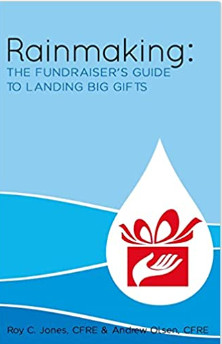Major giving metrics in a multi-channel world is nothing short of confusing.
Response rates, data analysis, cost of fundraising, contacts to presentation ratios, closing rates, results assessments, weekly activity reports… Managing a successful major gift program in context of the rest of your fundraising is enough to make your head spin. Performance measurements are moving targets today and confounded by the channel integration of the telephone, mail, email, social media, one-on-one meetings and, of course, fundraising events.
I have often chuckled over the fact that so many business leaders, including Peter Drucker, Tom Peters and dozens of others, taking credit for first using the quote: “What gets measured is what gets done.” As a matter of fact, I have even had a few my old bosses take credit for the quote too. Regardless of who gets the credit for the maxim, success only happens in major gift development when it is measured.
Before looking at the metrics, I would like to begin with where we want end. What does success look like for a full time major gift officer or senior staff member calling on individual, businesses and other funders to your organization?
- A full time major gift officer should conduct an average of between 3 to 5 visits a week. That equates to 12 to 15 visits a month; 145 to 180 meetings a year.
- Gift officers should visit approximately 75 percent of their portfolio each year. So if the minimal annual meeting goal is 150, the maximum number of assignments to a gift officer should never exceed 200 people.
- Approximately one-third of a gift officer’s portfolio should be in the solicitation stage.
Notice that I did not list a financial goal or annual fundraising objective. The secret to successful major gift fundraising is measuring the activity, not counting the money. Trust me when I tell you that if the activity is being measured and the major gift staff is held to a standard of activity HUGE SUMS OF CASH WILL FOLLOW.
However, if you simply measure the amount of revenue raised each month by you and your staff problems will follow. Reward activity and incentivize the number of meetings, presentations and asks. Strange things can happen when you are just looking at the money and rewarding your staff for the amount of cash raised. I have seen it all.
I once had a client who over a period of 36 month period rewarded and compensated their gift officers for increasing revenue from their portfolios. The strange thing was that overall giving to the organization had declined. The charity threatened to fire their direct response fundraising company. They reached out and hired tens of thousands of dollars on consultants to diagnose the problem.
When they hired me I was fortunate enough to understand the importance of measuring the activity, not just counting the money. As I drilled down to find the solution I discovered that the activity of the 5 major gift officers had declined dramatically each year, while total giving in their portfolio increased. Things did not add up. I asked for a source code report of all the donors and the discover I found was worse than anything I had ever seen. Each of the members of the major gift team had permission to recode donors in the data base to their own portfolio. They had assigned themselves over 1,500 names each from the regular donor program. They had pulled the best performing donors every month out of the direct mail and email program to assign the income they’d generated that year to their portfolio. While well intentioned, the majority of these donors actually gave less because they were no longer being solicited on a monthly basis. And because each major gift officer could only meet with 100 or so year, thousands and thousands of the organizations best supporters were not being cultivated or solicited at all.
Over 2 or 3 years pulling every $500, $1,000 and $5,000+ donor out of the direct mail and email program had a devastating impact on the organization. Evan after we fixed the problem, thousands and thousands of these donors lapsed and could never be reacquired. These donors, the charity’s best donors, simply moved on to other non-profits because they were not being solicited.
Expanded portfolios are not the only problems that happen when you are just “counting the money”. I saw another charity who promoted a young twenty-something to vice president of major gifts because he had taken a phone call and then met with a senior citizen who was liquidating their estate and gave the young whiz kid a check for $1 million. When I talked to the wonder boy 16 months after his $1 million donation he had not received another donation larger than $500 bucks. He was clueless but likeable and it was costing the charity millions each year.
When non-profits only watch the income report on a monthly or quarterly basis strange things happen… Let’s say the organization has a fundraising dinner, golf tournament or a walk-a-thon fundraiser that sparks a big week in revenue for the organization. What happens? You guessed it, the major gift officers take a break. They’ll be using their vacation days, their comp time. They’ll be having family emergencies or just calling in sick. The sad fact is when a major gift or development person is exceeding their quota or income goals, they “check out”. Even if they are in the office, they are mentally somewhere else.
While you might say, well they deserve it. They hit their number. The fact is when a week happens when nothing happens… your moves management process begins to unravel very quickly.
Getting donors to sit down with you is a cycle. You have to get the pump primed before most donors say, “yes, let’s meet”. It might take 10 phone calls, 3 voice mail messages, a handwritten note and 2 or 3 actually phone conversations to get a visit. When you interrupt this cycle for one week, two weeks or even, three weeks, guess what? You have to start all over.
Allowing your major gift team to “check out” after a big event or they have hit their goal can have a devastating impact on your organizations income and financial growth. If you are serious about growing your income and increasing major gifts, stop counting the money and start measuring the activity.
Your plan should outline the organizations goals for major gift fundraising and its role in your overall development program. Your plan should create a general strategy of opportunities for engaging the donor with the organization, but most importantly, your plan should include hundreds of individual plans with deadlines for cultivating each individual relationship.
If you build the relationship, the money will follow… if your contact with donors is only about money it will not succeed. Remember, your major gift program consists of hundreds of individual donor plans.
Yes, your program goals may be fairly obvious. Maybe you want to increase the number of major donors by 10% this year and increase overall giving by this group by 25%. What is not obvious is the work required to accomplish such tasks. Remember, major gift development is not something that is done with mass marketing techniques. Building real relationships with donors will not happen on Facebook or by email or by direct mail letter. Friendships are built only one way. They happen one-on-one, face to face.
In order to grow your major gift program it comes down to one message, “all hands on deck!” The only way to expand your major gift program is to put more people on the job. I am not saying that you need to hire a large major gift staff, although in some cases that may be the right thing to do. Every organization needs to look at their development team, senior staff, board of directors, key volunteers and major donors in order to determine who has the skills cultivate relationships and ask for support from others.
The question that your organization has to determine is “how many meetings can we do?” How many individual meetings can you do a year, a month or each business day?
The 50-10-3 Rule. Remember, too, that you have to account for the time it takes to reach the donor by phone, mail or email in order to schedule a meeting. While this is a very broad generalization, I have always planned on talking to 10 people in order to schedule 2 to 3 visits. The real question then is what does it take to actually talk to ten people. In today’s market, dialing the phone over 50 times and leave about 20 voice mail messages is not unprecedented. Twenty voice mails (to 20 households) will result in reaching about half of them. If you talk to 10 people, only three will likely be able to meet the following week.
That’s right 50 phone calls in order to talk to 10 and meet with 3. It takes a lot of work. If you are like most not for profit executives you will now click back to your Facebook page and go back to your normal routine. However, if you are ready to roll up your sleeves and go to work… pick up the phone and start pounding out those phone calls. Don’t forget the 50-10-3 rule.



I seek you adice, May I email our business plan and proposal to you?
After my PhD research in medical education curriculum and practice I started Mend-the-Gap Foundation that focuses on deliberate mentoring of junior doctors transitioning into hospital situated learning. We prevent about 110,000 patient deaths per year. We are endorsed by medical educati associations.
email: DHarrison@GEO7.org
Phone: 703-539-2754